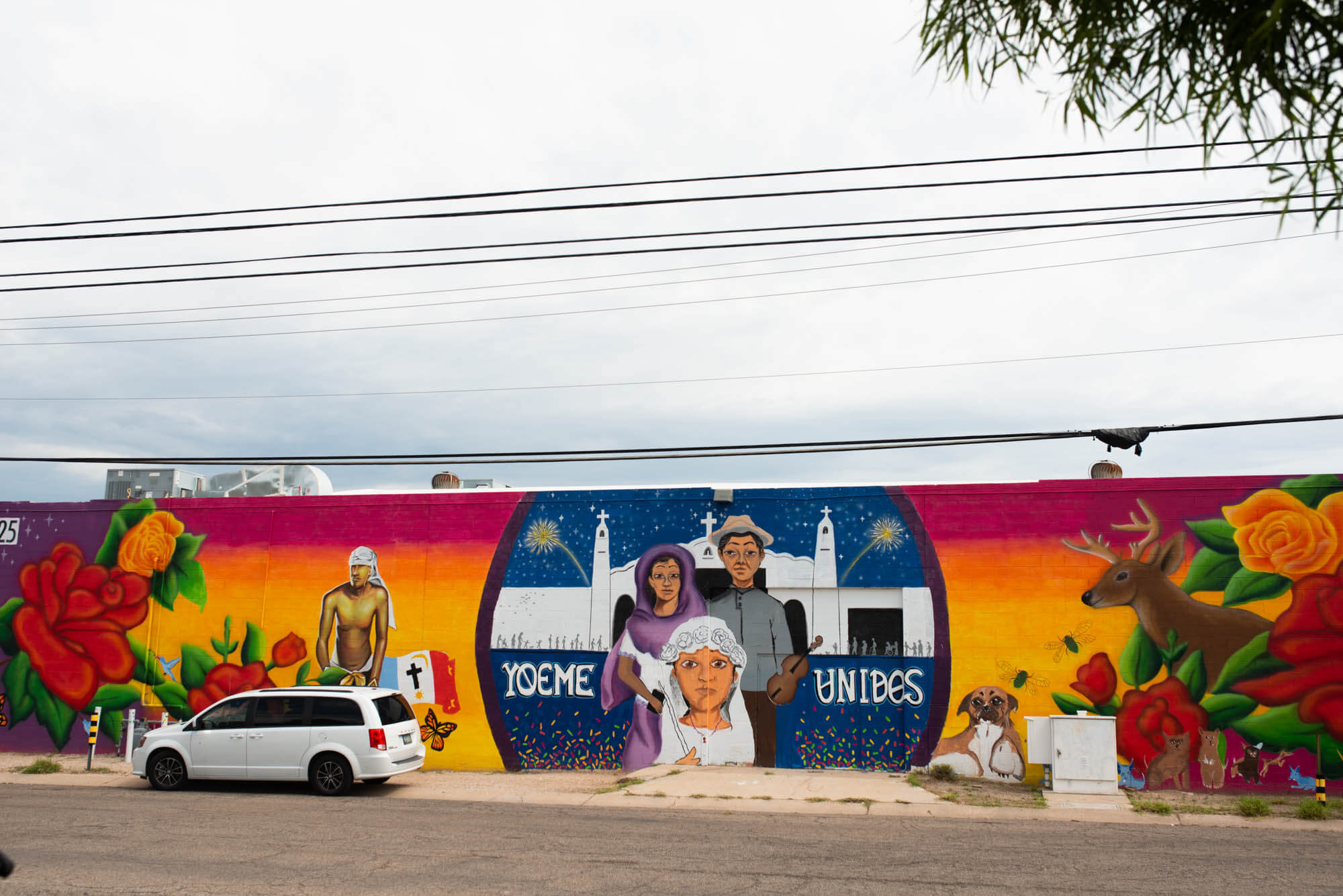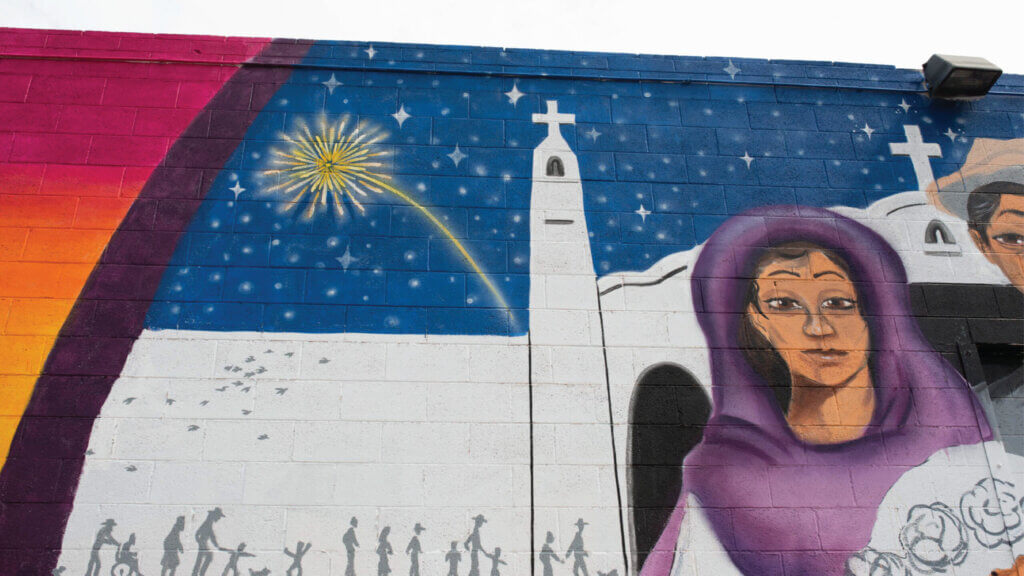
At 625 W. Rillito Street in Tucson, there used to sit a beige, windowless building with no conspicuous signage. It was the type of industrial warehouse you might drive by every day and never really notice. This one happened to be home to a cut and sew manufacturer called Postcraft, which had been operating there since the 1970s. Few people knew about it, not even those who lived in the neighborhood.
In June 2022 that changed. The building began to burst with vivid colors as a mural took shape across its massive facade. Now everyone notices.
A new tenant brought a new attitude in 2020 when Postcraft was purchased by Erica Yngve. First, the beige became a matte blue. It was a sort of bargain blue, made from mixing leftovers at the paint store. The color gave the building more distinctiveness against the drab industrial backdrop, but that was just a start. Erica also hung a small sign to reflect the name she had picked for her exciting new endeavor: Sonoran Stitch Factory.
About a year later, Sonoran Stitch Factory partnered with the Santa Cruz Valley National Heritage Foundation and the Pascua Yaqui Clubhouse of the Boys and Girls Club (the factory is situated next to a small but generations-old Pascua Yaqui community) to create the heritage mural on the factory’s west-facing wall.
The mural, Yoeme Unidos, was painted by two local artists, Anitra “Yukue” Molina, and Ignacio Garcia, along with seven Yaqui youth artists, aged 9–16. The kids were the main drivers of the mural’s content, which features elements of the desert environment, Yaqui Easter celebration, and the importance of family and women as the backbone of the community.
As for Erica, she had just two requests for the mural: that it depict bringing people together, and that it include an element of sewing to tie it in with what is happening behind its massive “canvas.”

Beyond the Wall
Walking into the factory is like entering a 20,000 square-foot time capsule. There isn’t a glowing screen in sight amid a sea of plain wooden tables adorned with tailor’s tape, heavy shears, and cutting mats. Here and there, hand-crank pencil sharpeners are affixed to walls and desks.
A flyer in the breakroom says “Let’s play board games together!” with a time and date for employees to have good old-fashioned fun on a Thursday afternoon. The overall vibe is sweet; workers smile and chat, some whistle or sing. The pace is measured and easy.
“It doesn’t feel like work, it feels like I’m playing,” says Maggie Salcedo, who grew up sewing with her mother to earn extra money for the family. She started a job as a cutter for Sonoran Stitch and has quickly moved up to Production Supervisor. “It’s taken me on a whole new path. The opportunities are here, I love it. I’ve learned a lot in just a year and a half.”
Opportunity Built on Connections
In 2019, Arizona native Erica Yngve was at loose ends. Her kids were in school and she wanted to start a small business. She loved sewing and fashion, having gotten her start in 4-H as a child, where her mother was the leader of the clothing project. She had an idea, and between support from FABRIC, a fashion incubator in Tempe, and the prize money she co-won through the Startup Tucson / TENWEST IdeaFunding pitch competition, she was able to launch Bralessly, a line of shirts for those wanting to go braless without it being obvious.
Soon after launch, Erica met Quinlan Wilhite at a Startup Tucson event, where he was giving a talk on his business, QMULATIVE, and his iconic AZ Pocket Tees. Erica was looking for a local manufacturer, so Quinlan pointed her in the direction of Nancy Lambert, owner of Postcraft, a 90-year old company that relocated from Cleveland in the 70’s. It was a perfect fit for Erica who wanted to support a local, woman-owned manufacturer.
When Nancy decided to retire in 2020, Erica saw a life-changing opportunity, and bought Postcraft. To start, she would produce her own line and the lines of local designers. Her bigger ambition was to establish Tucson as a hub for sewn goods manufacturing.
She picked up production where Nancy left off. Part of that was manufacturing AZ Pocket Tees for Quinlan, whose business had recently grown significantly. He had been sewing it all himself and needed help.
“Erica runs a tight ship over there, it’s nice to have her team do what they’re great at so I can focus on design, Phoenix Fashion Week, and community collaboration,” he says. “She’s given me my time back.”
The feeling is mutual. “I credit Quinlan 100% with making the original connection between me and this place,” she says.

Finding Partners Among Neighbors
At the time, Erica knew very little about the neighborhood her business sat beside. Part of her goal was finding a workforce for the sewn goods industry, which according to her, is growing exponentially. When she learned of her business’ proximity to the Yaqui tribe, she knew she wanted to connect—not only to develop workforce opportunities, but to be a partner in the community, assisting and supporting in ways it needed.
She had spoken with Moonshot, an AZ-based nonprofit that helps cities develop entrepreneurial ecosystems. They put her in touch with the City of Tucson’s Economic Development team, who in turn put her directly in touch with the tribe, which was actively seeking a workforce training program. The synchronicity wasn’t lost on Erica, and she took steps toward a partnership. She connected with Rebekah Lewis, Assistant Tribal Planner, who set up a meeting and a tour of the factory. The interest was mutual and a partnership was born. In January 2022 the workforce development program, AZ Stitch Lab, began.
AZ Stitch Lab resides inside the factory. The program provides free industrial sewing training and certification to community members who are interested in working in the sewn goods industry, or starting their own business. Rows of machines are dedicated to student use, both during class time and in between. Cohorts meet for six weeks and cover basic industrial sewing, apparel construction, and patterning.
The partnership is working. QMULATIVE and Sonoran Stitch Factory have been able to grow together, including fulfilling QMULATIVE’s largest order to date for Vantage West, printing 600 custom AZ Pocket Tees for the entire staff.
As of August 2022, twenty tribal members have participated, and forty students have graduated. The program is incredibly popular, with classes filling up almost immediately.
“I had to take the flier down off our website, I was getting so many emails!” says Rebekah. She has high hopes for the expansion of the program over the next few years, “So I can serve even more members of my community.”
The quick rise of Sonoran Stitch Lab (which was recently awarded Startup of the Year at the Tucson Metro Chamber Copper Cactus Awards) and their partnership with AZ Stitch Lab shows the power of intentional economic development that fosters local talent. When smart entrepreneurs like Erica are provided with support and resources to seize an opportunity they see, their venture grows and it drives demand for skilled employees. A little help from public-private partnerships creates the ability to champion workforce development; now people are able to obtain career skills and upward mobility they didn’t previously have, and the business venture can continue to prosper. This is a local economic system and connected community at its best.

A Mural’s Promise
At dusk, the sun’s warm light enlivens the already rich colors of the mural as factory workers are heading out for the day. Erica points out the embroidery on the mother’s shawl—the artists’ nod to their partnership.
Like the mural that adorns it, the Sonoran Stitch Factory is a vibrant expression of the power of community and the strong women who lead it. Every connection becomes a new opportunity for people from diverse backgrounds with varied interests to earn a livelihood and pursue a passion. Now they have a place to go that is filled with color and artistry, creativity and collaboration.
Perhaps the mural is a better window into what’s happening behind the walls of that factory than any glass pane ever could be.

